ML model¶
Now that we have set up user creation and authentification, we need our main selling point - the machine learning model. We will create an ML model that outputs how likely is a person surviving after a heart attack given a set of features [Davide Chicco, 2020].
The data source can be found here: https://www.kaggle.com/andrewmvd/heart-failure-clinical-data
Python packages¶
# Data wrangling
import pandas as pd
# Xgboost model
import xgboost as xgb
# Directory traversal
import os
# Classifier accuracy
from sklearn.metrics import roc_auc_score
# Ploting
import matplotlib.pyplot as plt
# Train test split
from sklearn.model_selection import train_test_split
# Array math
import numpy as np
# Model saving
import pickle
import json
# Cross validation split
from sklearn.model_selection import KFold
# Parameter grid creation
from sklearn.model_selection import ParameterGrid
Data input¶
# Input data
d = pd.read_csv('ML_API/ml_input/heart_failure_clinical_records_dataset.csv')
print(f"Shape of data: {d.shape}")
# Listing out the columns
print(f"Columns:\n{d.columns.values}")
# Printing out the head of data
print(f"Head of data:\n{d.head()}")
Shape of data: (299, 13)
Columns:
['age' 'anaemia' 'creatinine_phosphokinase' 'diabetes' 'ejection_fraction'
'high_blood_pressure' 'platelets' 'serum_creatinine' 'serum_sodium' 'sex'
'smoking' 'time' 'DEATH_EVENT']
Head of data:
age anaemia creatinine_phosphokinase diabetes ejection_fraction \
0 75.0 0 582 0 20
1 55.0 0 7861 0 38
2 65.0 0 146 0 20
3 50.0 1 111 0 20
4 65.0 1 160 1 20
high_blood_pressure platelets serum_creatinine serum_sodium sex \
0 1 265000.00 1.9 130 1
1 0 263358.03 1.1 136 1
2 0 162000.00 1.3 129 1
3 0 210000.00 1.9 137 1
4 0 327000.00 2.7 116 0
smoking time DEATH_EVENT
0 0 4 1
1 0 6 1
2 1 7 1
3 0 7 1
4 0 8 1
Collumn explanation¶
We will be using the following columns in our model:
DEATH_EVENT - boolean - whether the patient died or not after the heart attack.
age - float - age durring heart attack.
anaemia - boolean - decrease of red blood cells.
creatinine_phosphokinase - float - level of the CPK enzyme in the blood (mcg/L).
diabetes - boolean - whether the patient has diabetes or not.
ejection_fraction - float - percentage of blood leaving the heart at each contraction (percentage).
high_blood_pressure - boolean - whether the patient has high blood pressure or not.
platelets - float - platelets in the blood (kiloplatelets/mL)
serum_creatinine - float - serum creatinine level (mg/dL).
serum_sodium - float - serum sodium level (mEq/L).
sex - boolean - woman or man (binary).
smoking - boolean - whether the person smoked or not.
# Defining the columns and saving for later
y_var = 'DEATH_EVENT'
# Numerics
numeric_columns = [
'age',
'creatinine_phosphokinase',
'ejection_fraction',
'platelets',
'serum_creatinine',
'serum_sodium'
]
# Categoricals
categorical_columns = [
'anaemia',
'diabetes',
'high_blood_pressure',
'sex',
'smoking'
]
EDA¶
Y variable distribution¶
# Distribution of the binary variable
counts = d.groupby(y_var, as_index=False).size()
counts['distr'] = counts['size'] / counts['size'].sum()
# Visualizing the distribution
plt.bar(counts['DEATH_EVENT'].astype(str), counts['distr'])
plt.xlabel("DEATH_EVENT")
plt.ylabel("Share of total observations")
plt.title("Distribution of DEATH_EVENT")
Text(0.5, 1.0, 'Distribution of DEATH_EVENT')

The Y variable classes are not perfectly balanced but we cannot say that they are extremely unbalanced as well (in some cases, one class observations comprise less than 1% of data).
In our model, we will not be doing any artificial class balancing.
Numeric feature impact¶
## Numeric feature impact
for column in numeric_columns:
plt.figure(figsize=(7, 5))
plt.hist(d.loc[d[y_var] == 0, column], bins=20, alpha=0.5, label='No', density=True)
plt.hist(d.loc[d[y_var] == 1, column], bins=20, alpha=0.5, label='Yes', density=True)
plt.legend()
plt.xlabel(column)
plt.ylabel("Distribution")
plt.title(f"Distribution of {column} by DEATH_EVENT")
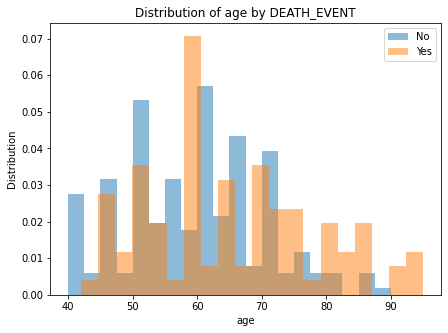
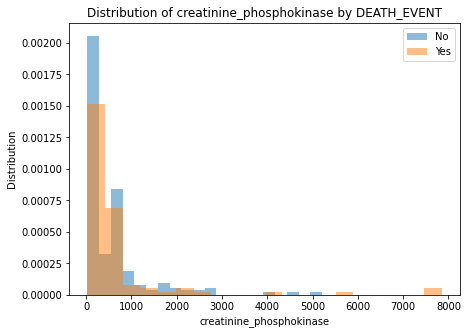
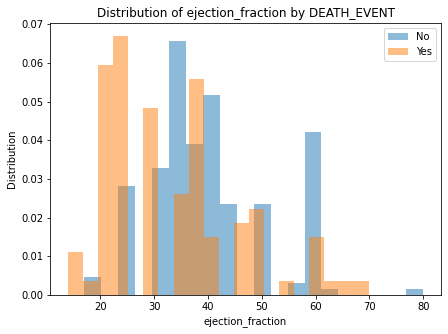
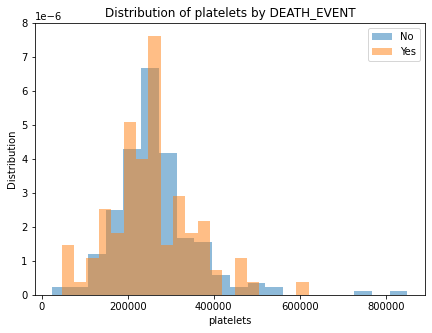

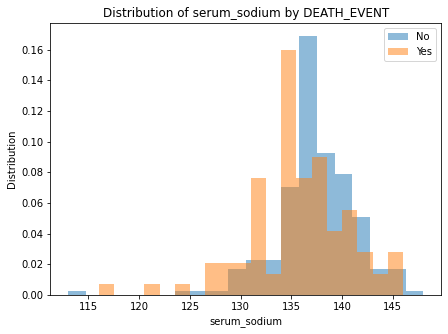
There are no clear separation of classes in either of the numeric features.
Xgboost model¶
We will do a 5 fold cross validation hyperparameter search in order to find the best XGB model.
# Defining the final feature list
final_features = numeric_columns + ['sex', 'high_blood_pressure']
# Defining a list of hyperparameters
hp_dict = {
'n_estimators': [30, 60, 120, 160],
'max_depth': [2, 3, 4, 5],
'learning_rate': [0.1, 0.2, 0.3],
'eval_metric': ['logloss'],
'use_label_encoder': [False],
'min_child_weight': [0.5, 1]
}
# Creating the parameter grid
param_grid = ParameterGrid(hp_dict)
# Initiating the empty placeholder for the AUC scores
auc_scores = []
# Iterating over the parameter grid
for params in param_grid:
# Spliting the data into 5 folds
kf = KFold(n_splits=5, shuffle=True, random_state=3)
# Initiating the empty placeholder for the scores
auc_scores_folds = []
# Iterating over the folds
for train_index, test_index in kf.split(d):
# Splitting the data into training and test sets
train, test = d.iloc[train_index], d.iloc[test_index]
train_X_fold, test_X_fold = train[final_features], test[final_features]
train_y_fold, test_y_fold = train[y_var], test[y_var]
# Creating the XGBoost model
model = xgb.XGBClassifier(**params)
# Fitting the model
model.fit(train_X_fold, train_y_fold)
# Predicting the test set
preds = model.predict_proba(test_X_fold)[:, 1]
# Calculating the AUC score
auc_scores_folds.append(roc_auc_score(test_y_fold, preds))
# Averaging the scores and appending to the master list
auc_scores.append(np.mean(auc_scores_folds))
# Creating the dataframe with the hyperparameters and AUC scores
df_scores = pd.DataFrame(param_grid)
df_scores['mean_auc'] = [round(x, 3) for x in auc_scores]
# Sorting by mean AUC score
df_scores = df_scores.sort_values('mean_auc', ascending=False)
df_scores.reset_index(drop=True, inplace=True)
# Printing the top 10 hyperparameters
print(f"Top 10 hyperparameters:\n{df_scores.head(10)}")
# Saving the best hyper parameters
best_hp = df_scores.iloc[0].to_dict()
del best_hp['mean_auc']
Top 10 hyperparameters:
eval_metric learning_rate max_depth min_child_weight n_estimators \
0 logloss 0.1 2 0.5 30
1 logloss 0.1 5 1.0 30
2 logloss 0.1 2 1.0 30
3 logloss 0.1 4 1.0 30
4 logloss 0.1 3 0.5 30
5 logloss 0.1 5 1.0 60
6 logloss 0.1 3 1.0 30
7 logloss 0.2 2 1.0 30
8 logloss 0.1 5 0.5 30
9 logloss 0.1 4 0.5 30
use_label_encoder mean_auc
0 False 0.776
1 False 0.774
2 False 0.770
3 False 0.768
4 False 0.767
5 False 0.760
6 False 0.760
7 False 0.759
8 False 0.758
9 False 0.755
Fitting the final model¶
We will be using xgboost as our final model for this project.
The final hyperparameters are the top ones from the K-FOLD analysis.
# X and Y for the model
X, Y = d[final_features].copy(), d[y_var].values
# Fitting the model
clf = xgb.XGBClassifier(**best_hp)
clf.fit(X, Y)
XGBClassifier(base_score=0.5, booster='gbtree', colsample_bylevel=1,
colsample_bynode=1, colsample_bytree=1, enable_categorical=False,
eval_metric='logloss', gamma=0, gpu_id=-1, importance_type=None,
interaction_constraints='', learning_rate=0.1, max_delta_step=0,
max_depth=2, min_child_weight=0.5, missing=nan,
monotone_constraints='()', n_estimators=30, n_jobs=16,
num_parallel_tree=1, predictor='auto', random_state=0,
reg_alpha=0, reg_lambda=1, scale_pos_weight=1, subsample=1,
tree_method='exact', use_label_encoder=False,
validate_parameters=1, verbosity=None)
# Creating the feature importance frame
feature_importance = pd.DataFrame({
'feature': final_features,
'importance': clf.feature_importances_
}).sort_values("importance", ascending=True)
# Ploting
plt.figure(figsize=(7, 5))
plt.barh(feature_importance['feature'], feature_importance['importance'])
plt.ylabel("Feature")
plt.xlabel("Importance")
plt.title("Feature importance")
plt.show()

Saving all the necessary objects¶
In order to successfuly serve the model, we need to save all the necessary objects. The objects are:
The model itself.
The input data schema.
The input data schema will be saved as a dictionary in a JSON file with the following structure:
{
"input_schema": {
"columns": [
{
"name": "column_name",
"type": "float"
},
{
"name": "column_name",
"type": "float"
},
...
]
}
}
The model will be saved as a pickle file as well.
print(f"Final feature list in the correct order:\n{X.columns.values}")
# Creating the input schema
features = []
for col in X.columns:
if col in numeric_columns:
features.append({
"name": col,
"type": "numeric"
})
else:
features.append({
"name": col,
"type": "boolean"
})
input_schema = {
"input_schema": {
"columns": features
}
}
# Creating the output dir
output_dir = os.path.join("ML_API", "ml_model")
if not os.path.exists(output_dir):
os.makedirs(output_dir)
# Saving the model to a pickle file
with open(os.path.join(output_dir, "model.pkl"), "wb") as f:
pickle.dump(clf, f)
# Saving the input schema
with open(os.path.join(output_dir, "input_schema.json"), "w") as f:
json.dump(input_schema, f)
Final feature list in the correct order:
['age' 'creatinine_phosphokinase' 'ejection_fraction' 'platelets'
'serum_creatinine' 'serum_sodium' 'sex' 'high_blood_pressure']
Now that we have these files, we can use them in our ML API. When serving machine learning, it is always a good practice to save the input schema as well as the model. The schema will be used to preprocess the incoming data from users and make it ingestable by the model.
In the next chapter, we will create more database models and endpoints to serve predictions from our model.